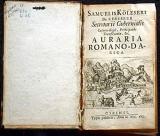2025. July 19. Saturday
Central Museum of Mining - Sopron

|
Address: 9400, Sopron Templom utca 2.
Phone number: (99) 312-667, (99) 338-902
E-mail: info@kbm.hu
Opening hours: 01.04-31.10.: Tue-Sun 10-18
01.11-31.03.: Tue-Sun 10-16 |
The museum of the thousand year old Hungarian mining was opened in the Baroque downtown of Sopron in 1957, October the 13th in the former Esterházy-castle in Templom street 2. The foundation of the museum was furthered by Dr. Jenő Faller professional mining engineer, who was a professor of the Sopron School of Forestry.
The millennial town of Sopron has had centuries old connections with mining even before the opening of our museum. Mineral coal was first discovered in 1753 in the historical Hungary, in the woods around Sopron in the area, which is now called Brennbergbánya. Here the coal was started to be used for industrial purposes with very good results until 1951.
In 1920, The School of Mining and Forestry that was transferred here from Selmecbánya according to the "Decision of Trianon" started to function in Sopron.
We know almost everything about the seven century long history of the building where the museum has been located for almost 50 years. The oldest (northern) part of the building was built in the 14th century, and was extended to "U" shape during the rule of Sigismund. In the 16-17th centuries the house used to give accommodation for the superintendents of Sopron. The building complex was renovated between 1560 and 1650 to renaissance style, and Miklós Esterházy renovated it to baroque style after 1752. The music pavilion in the bastion garden (hanging garden) that serves Joseph Haydn among others was completed in 1781. The renovation of the complex as a historic building was finished in 1980.
Each year there are two or three periodic exhibitions in the museum besides our permanent exhibition, which was opened in September 2000 and is about the millennium long mining of the Carpathian Basin. This exhibition is captioned in four languages.
The millennial town of Sopron has had centuries old connections with mining even before the opening of our museum. Mineral coal was first discovered in 1753 in the historical Hungary, in the woods around Sopron in the area, which is now called Brennbergbánya. Here the coal was started to be used for industrial purposes with very good results until 1951.
In 1920, The School of Mining and Forestry that was transferred here from Selmecbánya according to the "Decision of Trianon" started to function in Sopron.
We know almost everything about the seven century long history of the building where the museum has been located for almost 50 years. The oldest (northern) part of the building was built in the 14th century, and was extended to "U" shape during the rule of Sigismund. In the 16-17th centuries the house used to give accommodation for the superintendents of Sopron. The building complex was renovated between 1560 and 1650 to renaissance style, and Miklós Esterházy renovated it to baroque style after 1752. The music pavilion in the bastion garden (hanging garden) that serves Joseph Haydn among others was completed in 1781. The renovation of the complex as a historic building was finished in 1980.
Each year there are two or three periodic exhibitions in the museum besides our permanent exhibition, which was opened in September 2000 and is about the millennium long mining of the Carpathian Basin. This exhibition is captioned in four languages.


